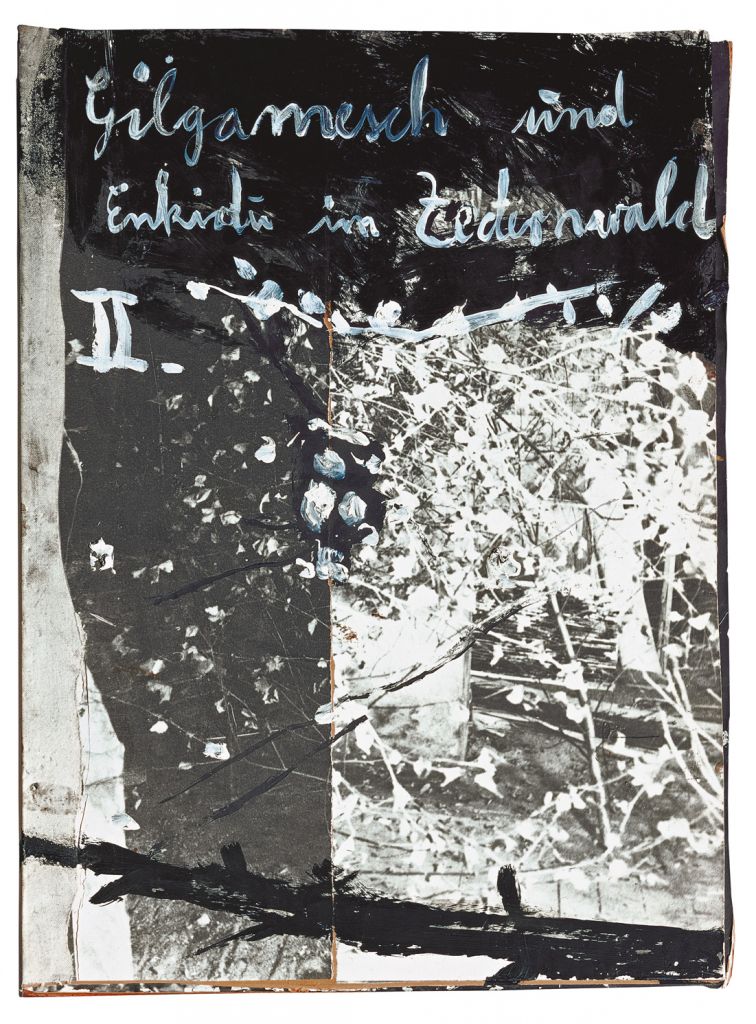The Paths of World Wisdom: Hermann’s Battle
1982–93Woodcut, emulsion, oil, and collage on paper on canvas491 x 612.5 x 3.9 cm
Born in Germany just months before the final European battle of World War II, Anselm Kiefer grew up witnessing the results of modern warfare and the division of his homeland. He also experienced the rebuilding of a fragmented nation and its struggle for renewal. Kiefer dedicated himself to investigating the interwoven patterns of German mythology and history and the way they contributed to the rise of Fascism. He confronted these issues by violating aesthetic taboos and resurrecting sublimated icons. In one of his earliest projects, his 1969 Occupations (Besetzungen) series, Kiefer photographed himself mimicking the Nazi salute at various sites during a journey through Switzerland, France, and Italy. Subsequent paintings—immense landscapes and architectural interiors, often encrusted with sand and straw—invoke Germany's literary and political heritage; references abound to the Nibelung legends and Richard Wagner, Albert Speer's architecture, and Adolf Hitler. Beginning in the mid-1980s, and especially following his move to southern France in the early 1990s, Kiefer's iconography expanded to encompass more universal themes of civilization, culture, and spirituality, drawing upon such sources as the Kabbalah, alchemy, and ancient myth.
The Paths of World Wisdom: Hermann's Battle (Wege der Weltweisheit: Die Hermannsschlacht, 1982–93) depicts a tangled pantheon of historical German figures, whose portraits are set within a forest and connected by the superimposed rings of tree trunks. It belongs to a series of similar large woodcut collages that Kiefer created in the late 1970s and early 1980s. The title alludes to Hermann—also known by his Roman name, Arminius—who successfully led the Germanic tribes against the Romans at the Battle of Teutoburg Forest in 9 CE, thereby ensuring that Germania remained independent from the Roman Empire. Hermann became a powerful symbol for 19th-century German nationalists, and during the Third Reich the Nazis used his myth to proclaim the racial superiority of the so-called "Aryan" race. The figures represented here range from 18th- and 19th-century intellectuals, poets, and composers, to Prussian leaders and industrialists, to Nazi military leaders. The portraits were largely based upon those in a 1937 book, Face of the German Leader: 200 Portraits of German Fighters and Pioneers across 2000 Years, which presented a legitimating genealogy of Nationalist Socialism.[1] In Kiefer's composite woodcut, the heads of these various figures are densely and roughly interposed without any seeming order, and a sinister bonfire expands from the work's center, just below the portrait of Hermann himself.
Kiefer's selection of medium here is closely calibrated to the subject: woodcutting is a traditional technique deeply associated with German art, from the great Renaissance artist Albrecht Dürer to 20th-century Expressionists, like Ernst Ludwig Kirchner, who self-consciously revived it. Kiefer has used composite woodcuts in a number of his works, including another piece in the Guggenheim Museum Bilbao collection, Untitled (The Rhine) (Ohne Titel [Der Rhein], 1982).
1. See Hans Dickel, "Off the Beaten Track: On the Series Ways of Worldly Wisdom," in Klaus Gallwitz, ed., Anselm Kiefer: Wege der Weltweisheit/Die Frauen der Revolution (Düsseldorf: Richter Verlag, 2007).
Source(s):
Nancy Spector. "Anselm Kiefer." In Spector, ed. Guggenheim Museum Collection: A to Z. 3rd rev. ed. New York: Guggenheim Museum, 2009.
Miguel López-Remiro. "Anselm Kiefer." In Guggenheim Museum Bilbao Collection. Bilbao: Guggenheim Museum Bilbao; Madrid: TF Editores, 2009.
"Anselm Kiefer." In The Permanent Collections of the Guggenheim Museums. Bilbao: Guggenheim Museum Bilbao, 2007.
Original title
Wege der Weltweisheit: Die Hermannsschlacht
Date
1982–93
Medium/Materials
Woodcut, emulsion, oil, and collage on paper on canvas
Dimensions
491 x 612.5 x 3.9 cm
Credit line
Guggenheim Bilbao Museoa










